Europe Commodity Proteins Market: Insights into Soy Protein Isolate Adoption and Applications

“The European commodity protein market, particularly the soy protein isolate and concentrate segment, has exhibited consistent growth in recent years and is anticipated to continue its expansion across major European economies. Soy protein, sourced from defatted soy flour through processing methods such as isolation and concentration, has emerged as a vital ingredient in a wide range of applications, including functional foods, dietary supplements, beverages, meat alternatives, and infant formulas. Its balanced amino acid profile, high protein content, and versatility in formulation position it as a preferred plant-based protein source for food manufacturers and consumers alike.”
Projections indicate that the total European market value for soy protein isolate/concentrate is set to reach USD 0.381 billion by 2030, with a compound annual growth rate (CAGR) of 4.3% from 2025 to 2030. This growth is driven by health-conscious consumption trends, regulatory support, and innovation in the applications of plant-based proteins.
Germany stands out as a key market for soy protein isolate/concentrate in Europe, with its market value projected to reach USD 0.1248 billion by 2030 and a CAGR of 4.6%. The robust food manufacturing sector, along with a rising demand for high-protein, plant-based alternatives, fuels this growth. German consumers increasingly favor vegetarian and vegan diets, leading food manufacturers to incorporate soy proteins into bakery products, dairy alternatives, and nutritional supplements. Additionally, Germany’s strict food safety and quality standards ensure compliance with European regulations, further reinforcing consumer confidence in plant-based proteins. Innovations in extraction and formulation techniques, such as the development of neutral-taste isolates and textured concentrates, enhance the application of soy protein across various product lines.
France also plays a significant role in the market, with projections indicating a market value of USD 0.061 billion by 2030 at a CAGR of 5.0%. French consumers show a strong inclination toward plant-based foods, motivated by sustainability and environmental consciousness, which encourages manufacturers to utilize soy protein as a clean-label, high-quality protein source. Notable applications include functional foods, sports nutrition, and infant formulas, as soy proteins serve as plant-based alternatives to dairy proteins for lactose-intolerant populations. French food and beverage companies leverage soy protein isolates and concentrates to produce fortified beverages, meat analogs, and protein-rich snacks that align with growing health and wellness trends.
Other Western European countries, including Spain, the UK, Italy, the Netherlands, and Ireland, present varied but positive growth trends. Spain's market is projected to reach USD 0.0176 billion by 2030, growing at a CAGR of 5.5%, reflecting an increased adoption of plant-based diets and heightened demand for fortified foods. The UK market is expected to reach USD 0.0521 billion by 2030, with a CAGR of 5.2%, driven by rising consumer interest in plant-based and vegan protein products, supported by a robust retail and food service sector. Italy, the Netherlands, and Ireland exhibit moderate growth, propelled by urbanization, dietary changes, and increasing awareness of the nutritional benefits of plant-based proteins.
In Eastern Europe, markets such as Poland and Romania, although smaller in absolute value, are beginning to emerge as growth areas for soy protein isolate and concentrate. Poland is projected to reach USD 0.0095 billion by 2030, with a CAGR of 2.0%, while Romania is expected to reach USD 0.0072 billion, growing at a CAGR of 3.3%. This growth is supported by rising disposable incomes, urbanization, and the expansion of modern retail channels, which enhance access to fortified foods, protein supplements, and plant-based alternatives. As Western European trends in health, wellness, and sustainability shape consumer preferences, demand for soy proteins is likely to increase steadily in these regions.
Several factors contribute to the growth of the soy protein isolate/concentrate segment across Europe. Increasing health awareness among consumers, particularly regarding muscle health, weight management, and cardiovascular wellness, has driven demand for high-protein, plant-based solutions. Regulatory support, including EU guidelines on nutrition labeling and functional claims, guarantees transparency and fosters product innovation. Additionally, manufacturers are investing in research to enhance the functional properties of soy proteins, such as solubility, emulsification, and taste masking, allowing for broader incorporation into diverse applications like beverages, meat substitutes, bakery items, and dairy alternatives.
Nonetheless, challenges persist in the market, primarily concerning price volatility of raw soybeans, dependency on imports, and competition from other plant-based proteins, including pea, rice, and oat proteins. Environmental concerns regarding soy production also pose a significant challenge that stakeholders must address.